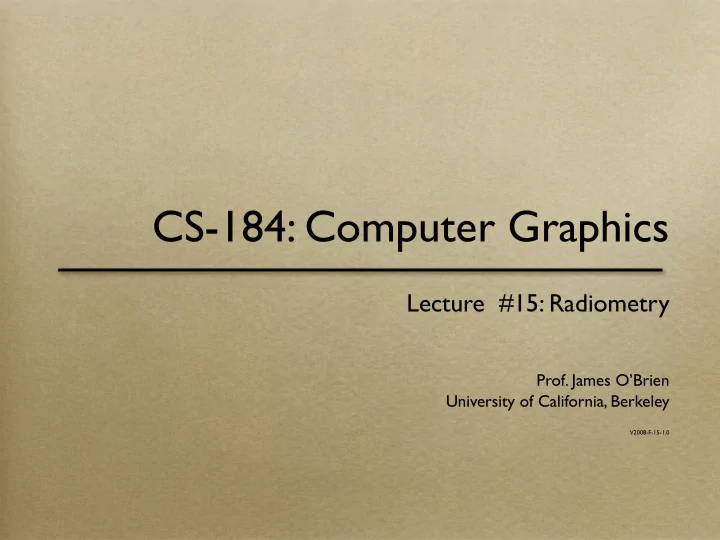

CS-184: Computer Graphics Lecture #15: Radiometry Prof. James O’Brien University of California, Berkeley V2008-F-15-1.0
Today Radiometry: measuring light Local Illumination and Raytracing were discussed in an ad hoc fashion Proper discussion requires proper units Not just pretty pictures... but correct pictures � 2
Matching Reality Unknown � 3
Matching Reality Photo Rendered Cornell Box Comparison Cornell Program of Computer Graphics � 4
Units Light energy Really power not energy is what we measure Joules / second ( J/s ) = Watts ( W ) Spectral energy density power per unit spectrum interval Watts / nano-meter ( W/nm ) Properly done as function over spectrum Often just sampled for RGB Often we assume people know we’re talking about S.E.D. and just say E... � 5
Irradiance Total light striking surface from all directions Only meaningful w.r.t. a surface W / m 2 Power per square meter ( ) W / m 2 / nm Really S.E.D. per square meter ( ) Not all directions sum the same because of foreshortening � 6
Radiant Exitance Total light leaving surface over all directions Only meaningful w.r.t. a surface W / m 2 Power per square meter ( ) W / m 2 / nm Really S.E.D. per square meter ( ) Also called Radiosity Sum over all directions ⇏ same in all directions � 7
Solid Angles Regular angles measured in radians Measured by arc-length on unit circle [ 0 .. 2 π ] Solid angles measured in steradians Measured by area on unit sphere [ 0 .. 4 π ] Not necessarily little round pieces... � 8
Radiance Light energy passing though a point in space in a given direction W / m 2 / sr Energy per steradian per square meter ( ) W / m 2 / sr / nm S.E.D. per steradian per square meter ( ) Constant along straight lines in free space d area=� D Ασ d 2 area=� D Ασ (kd) 2 kd � 9
Radiance Near surfaces, differentiate between Radiance from the surface ( surface radiance ) Radiance from other things ( field radiance ) L s L f � 10
Light Fields The radiance at every point in space, direction, and frequency: 6D function Collapse frequency to RGB, and assume free space: 4D function Sample and record it over some volume � 11
Light Fields � 12 Levoy and Hanrahan, SIGGRAPH 1996
Light Fields Levoy and Hanrahan, SIGGRAPH 1996 � 13
Light Fields Michelangelo’s Statue of Night From the Digital Michelangelo Project � 14
Computing Irradiance Integrate incoming radiance (field radiance) over all direction Take into account foreshortening Z H = Ω L f ( k ) cos ( θ ) d σ Z 2 π Z π / 2 H = L f ( θ , φ ) cos ( θ ) sin ( θ ) d θ d φ 0 0 k d σ n θ φ � 15
Revisiting The BRDF How much light from direction A goes out in direction B Now we can talk about units: BRDF is ratio of foreshortened field radiance to surface radiance L s ( θ o ) ρ ( θ i , θ o ) = L f ( θ i ) cos ( ∠ ˆ n θ ) detector light We left out frequency dependance here... k i k o Also note for perfect Lambertian reflector with constant BRDF ρ = 1 / π � 16
The Rendering Equation Total light going out in some direction is given by an integral over all incoming directions: Z L s ( k o ) = Ω ρ ( k o , k i ) L f ( k i ) cos ( θ ) d σ Note, this is recursive ( my is another’s ) L f L s � 17
The Rendering Equation We can rewrite explicitly in terms of L s Z L s ( k o ) = Ω ρ ( k o , k i ) L f ( k i ) cos ( θ ) d σ i ρ ( k o , k i ) L s ( x � x 0 , x 0 ) cos ( θ i ) cos ( ∠ ˆ n 0 ( x � x 0 )) δ ( x , x 0 ) Z d x 0 L s ( k o , x ) = || x � x 0 || 2 S Consider what ray tracing was doing.... � 18
Light Paths Many paths from light to eye Characterize by the types of bounces Begin at light End at eye “Specular” bounces “Diffuse” bounces � 19
Light Paths Describe paths using strings LDE, LDSE, LSE, etc. Describe types of paths with regular expressions Visible paths L{D|S}*E Standard raytracing L{D|S}S*E Local illumination L{D|S}E LD*E Radiosity method (have not talked about yet) � 20
Recommend
More recommend